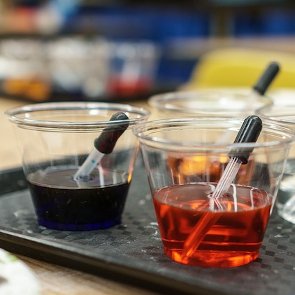5 Pairs of Skincare Ingredients That Work Well Together
 Some skincare ingredients (mostly harsh ones like AHA or retinol) shouldn’t be mixed together because this will be too much for your skin. Others, on the contrary, work well together and amplify each other’s effect. Here are 5 pairs of skincare ingredients that you can (and should) mix together.
Some skincare ingredients (mostly harsh ones like AHA or retinol) shouldn’t be mixed together because this will be too much for your skin. Others, on the contrary, work well together and amplify each other’s effect. Here are 5 pairs of skincare ingredients that you can (and should) mix together.AHAs / BHAs + Hyaluronic Acid
Alpha- and beta-hydroxy acids (AHAs and BHAs) are exfoliating agents that help loosen dead skin cells and remove them from your skin. Hyaluronic acid is a humectant that draws moisture to your skin and locks it in, keeping your skin hydrated. Despite the word “acid” in its name, hyaluronic acid is actually a very gentle ingredient that replenishes the moisture stripped away by AHAs and BHAs, which makes it a great follow-up to chemical peels.
Check this out: Pros and Cons of Using Salicylic Acid for Acne-Prone Skin
Retinol + Hyaluronic Acid
Retinol is a form of vitamin A that boosts the synthesis of collagen in the skin, reduces fine lines and wrinkles, improves skin tone, and fights acne. Unfortunately, it is also infamous for being harsh on the skin and causing redness, flaking, and dryness. If you want to experience the benefits of retinol without also having to experience its side effects, you should complement it with hyaluronic acid that will soothe and hydrate your skin.
Check this out: What Is the Difference Between Emollients, Humectants and Occlusives?
Vitamin C + Vitamin E
Vitamin C (ascorbic acid) and vitamin E (tocopherol) are both powerful antioxidants that work in different ways. Vitamin E protects your skin from free radicals and slows down the aging process, while vitamin C stimulates collagen synthesis and provides enhanced UV protection. When combined together, they will protect your skin from aging even better.
There’s one thing you should keep in mind, though. Vitamin C is water-soluble, whereas vitamin E is oil-soluble. You should always apply water-based skincare products first, since oil will prevent them from penetrating your skin. For example, you can use a facial serum with vitamin C and follow up with a moisturizer with vitamin E.
Check this out: How to Choose the Right Facial Serum for Your Skin
Vitamins C and/or E + Ferulic Acid
Ferulic acid is a powerful antioxidant that combats free radicals and reduces oxidative damage to skin cells. If combined with other antioxidants, such as ascorbic acid or tocopherol, it provides even more protection against free radicals. Don’t hesitate to make the most of it!
Check this out: 5 Ingredients to Look for in a Face Serum
Vitamin C or Retinol + SPF
Although sunscreens do block most of UVB radiation, they cannot provide 100% protection. Vitamin C and other antioxidants enhance UV protection by neutralizing the free radicals that have been produced by UV exposure.
Retinol should be combined with SPF for another reason. This ingredient stimulates skin cell turnover, leaving your skin more vulnerable to UV radiation. Therefore it’s important to give your skin extra protection from the sun.
Check this out: How to Choose the Best Sunscreen for Your Face
Breadcrumbs
Filters
- Face
Tags
Related Articles
- 5 Effective Ingredients in Anti-Wrinkle Creams, 4 Ingredients to Avoid in Products for Acne-Prone Skin, 5 Ingredients to Avoid in Makeup Products, 4 Pairs of Skincare Ingredients You Should Never Mix